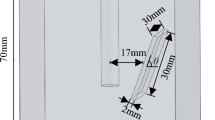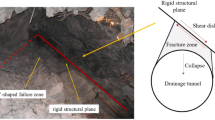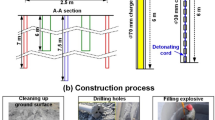Abstract
With the increase of the depth of the underground engineering, the phenomenon of splitting failure of the deep rock will appear, which is very different from the shallow cavern. In order to reveal the formation mechanism of splitting failure, mechanical model test and numerical simulations of splitting failure were carried out respectively. Using the Pubugou Hydropower Station as the engineering background, a three-dimensional (3D) geomechanical model test was conducted relying on a high stress three-dimensional load test system. The splitting failure phenomenon of high sidewall cavern was observed, and the oscillation variations of displacement and stress were measured. Based on strain gradient theory and continuum damage mechanics, an elastic–plastic damage softening model for splitting damage was established. The relationship between rock damage and energy dissipation was analyzed. Based on the strain energy density theory, the splitting failure criterion based on the strain gradient is established. A numerical analysis method for splitting damage was proposed, and a regional disintegration calculation program was developed based on a commercial finite element code. The numerical simulation results are in basic agreement with the 3D geomechanical model test.













Similar content being viewed by others
References
Bauch E, Lempp C (2004) Rock splitting in the surrounds of underground openings: an experimental approach using triaxial extension tests. In Engineering geology for infrastructure planning in Europe. Springer, Berlin, Heidelberg, pp 244–254
Chen XG, Wang Y, Zhang QY, Li SC, Nordlund E (2013a) Analogical model test and theoretical analysis on zonal disintegration based on filed monitoring in deep tunnel. Eur J Environ Civ Eng 17(sup1):s33–s52
Chen XG, Zhang QY, Wang Y, Li SC, Wang HP (2013b) In situ observation and model test on zonal disintegration in deep tunnels. J Test Eval 41(6):990–1000
Chen XG, Zhang QY, Wang Y, Liu DJ, Zhang N (2013c) Model test of anchoring effect on zonal disintegration in deep surrounding rock masses. Sci World J 2013:1–16. https://doi.org/10.1155/2013/935148
Dyskin AV, Sahouryeh E, Jewell RJ, Joer H, Ustinov KB (2003) Influence of shape and locations of initial 3-D cracks on their growth in uniaxial compression. Eng Fract Mech 70(15):2115–2136
Eshel NN, Rosenfeld G (1975) Axi-symmetric problems in elastic materials of grade two. J Franklin Inst 299(1):43–51
Fang Z, Harrison JP (2002) Development of a local degradation approach to the modelling of brittle fracture in heterogeneous rocks. Int J Rock Mech Min Sci 39(4):443–457
Fleck NA, Hutchinson JW (2001) A reformulation of strain gradient plasticity. J Mech Phys Solids 49:2245–2271
Gao Q, Zhang Q, Xiang W (2019) Mechanism of zonal disintegration phenomenon (ZDP) around deep roadway under dynamic excavation. Geotech Geol Eng 37(1):25–41
Gao Q, Zhang Q, Zhang X, Zhang L (2018) Geomechanical model test and energy mechanism analysis of zonal disintegration in deep surrounding rock. Geosciences 8(7):237
Gong QM, Yin LJ, Wu SY, Zhao J, Ting Y (2012) Rock burst and slabbing failure and its influence on TBM excavation at headrace tunnels in Jinping II hydropower station. Eng Geol 124:98–108
Gong FQ, Luo Y, Li XB, Si XF, Tao M (2018) Experimental simulation investigation on rockburst induced by spalling failure in deep circular tunnels. Tunn Undergr Space Technol 81:413–427
Gudmundson P (2004) A unified treatment of strain gradient plasticity. J Mech Phys Solids 52(6):1379–1406
Gurtin ME (2000) On the plasticity of single crystals: free energy, microforces, plastic-strain gradients. J Mech Phys Solids 48:989–1036
Gurtin ME (2002) A gradient theory of single-crystal viscoplasticity that accounts for geometrically necessary dislocations. J Mech Phys Solids 50:5–32
Gurtin ME (2003) On a framework for small-deformation viscoplasticity: free energy, microforces, strain gradients. Int J Plast 19:47–90
Gurtin ME, Anand L (2005) A theory of strain-gradient plasticity for isotropic, plastically irrotational materials. Part I: small deformations. J Mech Phys Solids 53(7):1624–1649
Hibino S (2001) Rock mass behavior of large-scale cavern during excavation and trend of underground space use. J Min Mater Process Inst Jpn 117(3):167–176
Jia P, Yang TH, Yu QL (2012) Mechanism of parallel fractures around deep underground excavations. Theor Appl Fract Mech 61:57–65
Jiang Q, Feng XT, Fan Y, Fan Q, Liu G, Pei S, Duan S (2017) In situ experimental investigation of basalt spalling in a large underground powerhouse cavern. Tunn Undergr Space Technol 68:82–94
Lam DC, Yang F, Chong ACM, Wang J, Tong P (2003) Experiments and theory in strain gradient elasticity. J Mech Phys Solids 51(8):1477–1508
Li SC, Feng XD (2013) Numerical model for the zonal disintegration of the rock mass around deep underground workings. Theor Appl Fract Mech 67:65–73
Li D, Li CC, Li X (2011) Influence of sample height-to-width ratios on failure mode for rectangular prism samples of hard rock loaded in uniaxial compression. Rock Mech Rock Eng 44(3):253–267
Liu HY, Kou SQ, Lindqvist PA (2002) Numerical simulation of the fracture process in cutting heterogeneous brittle material. Int J Numer Anal Meth Geomech 26(13):1253–1278
Liu G, Feng XT, Jiang Q, Yao Z, Li S (2017) In situ observation of spalling process of intact rock mass at large cavern excavation. Eng Geol 226:52–69
Martin CD, Maybee WG (2000) The strength of hard-rock pillars. Int J Rock Mech Min Sci 37(8):1239–1246
Mentzel A, Steinmann P (2000) On the continuum formulation of higher order gradient plasticity for single and polycrystals. J Mech Phys Solids 48:1777–1796
Mindlin RD (1965) Second gradient of strain and surface-tension in linear elasticity. Int J Solids Struct 1(4):417–438
Ortlepp WD (1997) Rock fracture and rockbursts: an illustrative study. South African Institute of Mining and Metallurgy
Ortlepp WD, Stacey TR (1994) Rockburst mechanisms in tunnels and shafts. Tunn Undergr Space Technol 9(1):59–65
Sahouryeh E, Dyskin AV, Germanovich LN (2002) Crack growth under biaxial compression. Eng Fract Mech 69(18):2187–2198
Sharif LK, Elmo D, Stead D (2019) Improving DFN-geomechanical model integration using a novel automated approach. Comput Geotech 105:228–248
Steinmann P (1994) A micropolar theory of finite deformation and finite rotation multiplicative elastoplasticity. Int J Solids Struct 31(8):1063–1084
Tang CA, Lin P, Wong RHC, Chau KT (2001) Analysis of crack coalescence in rock-like materials containing three flaws—part II: numerical approach. Int J Rock Mech Min Sci 38(7):925–939
Tao M, Li X, Wu C (2013) 3D numerical model for dynamic loading-induced multiple fracture zones around underground cavity faces. Comput Geotech 54:33–45
Wang Z, Li Y, Zhu W, Xue Y, Yu S (2016) Splitting failure in side walls of a large-scale underground cavern group: a numerical modelling and a field study. Springerplus 5(1):1528
Wong RHC, Law CM, Chau KT, Zhu WS (2004) Crack propagation from 3-D surface fractures in PMMA and marble specimens under uniaxial compression. Int J Rock Mech Min Sci 41:37–42. https://doi.org/10.1016/j.ijrmms.2004.03.016
Wowk D, Alousis L, Underhill PR (2019) An adaptive remeshing technique for predicting the growth of irregular crack fronts using p-version finite element analysis. Eng Fract Mech 207:36–47
Yang FACM, Chong ACM, Lam DCC, Tong P (2002) Couple stress based strain gradient theory for elasticity. Int J Solids Struct 39(10):2731–2743
Yoshida T, Ohnishi Y, Nishiyama S, Hirakawa Y, Mori S (2004) Behavior of discontinuties during excavation of two large underground caverns. Int J Rock Mech Min Sci 41(SUPPL. 1)
Zbib HM, Aifantis EC (1988a) A gradient-dependent model for the Portevin-Le Chatelier effect. Scr Metall 22(8):1331–1336
Zbib HM, Aifantis EC (1988b) On the structure and width of shear bands. Scr Metall 22(5):703–708
Zhang XT (2015) The research on failure mechanism and numerical simulate on analysis of zonal disintegration in deep tunnel. Doctoral dissertation, Shandong University. (in Chinese)
Zhang QY, Zhang XT, Xiang W, Chen X, Cao G, Xu X (2013) Model test study of zonal disintegration in deep rock mass under different cavern shapes and loading conditions. Chin J Rock Mechan Eng 32(8):1564–1571
Zhang Q, Zhang X, Wang Z, Xiang W, Xue J (2017) Failure mechanism and numerical simulation of zonal disintegration around a deep tunnel under high stress. Int J Rock Mech Min Sci 93:344–355
Zhang Q, Liu C, Duan K, Zhang Z, Xiang W (2019a) True three-dimensional geomechanical model tests for stability analysis of surrounding rock during the excavation of a deep underground laboratory. Rock Mechanics and Rock Engineering, pp 1–21
Zhang QY, Ren MY, Duan K, Wang WS, Gao Q, Lin HX et al (2019b) Geo-mechanical model test on the collaborative bearing effect of rock-support system for deep tunnel in complicated rock strata. Tunnel Undergr Space Technol 91:103001
Zhang QY, Zhang Y, Duan K, Liu CC, Miao YS, Wu D (2019c) Large-scale geo-mechanical model tests for the stability assessment of deep underground complex under true-triaxial stress. Tunn Undergr Space Technol 83:577–591
Q Zhang, F Li, K Duan, G Yu, L Cheng, X Guo (2021) Experimental investigation on splitting failure of high sidewall cavern under three-dimensional high in-situ stress. Tunn Undergr Space Technol 108:103725. https://doi.org/10.1016/j.tust.2020.103725
Zhu WS, Li XJ, Zhang QB, Zheng WH, Xin XL, Sun AH, Li SC (2010) A study on sidewall displacement prediction and stability evaluations for large underground power station caverns. Int J Rock Mech Min Sci 47(7):1055–1062
Acknowledgements
This study was financially supported by the Natural Science Foundation of China (NO:41772282) and the Taishan Scholars Project Foundation of Shandong Province and the National Key Research Development Project of China (No. 2016YFC0401804).
Author information
Authors and Affiliations
Corresponding author
Ethics declarations
Conflict of interest
The authors declare that they have no conflict of interest.
Additional information
Publisher's Note
Springer Nature remains neutral with regard to jurisdictional claims in published maps and institutional affiliations.
Rights and permissions
About this article
Cite this article
Li, F., Zhang, Q., Xiang, W. et al. Failure Mechanism and Numerical Simulation of Splitting Failure for Deep High Sidewall Cavern Under High Stress. Geotech Geol Eng 40, 175–193 (2022). https://doi.org/10.1007/s10706-021-01891-z
Received:
Accepted:
Published:
Issue Date:
DOI: https://doi.org/10.1007/s10706-021-01891-z




